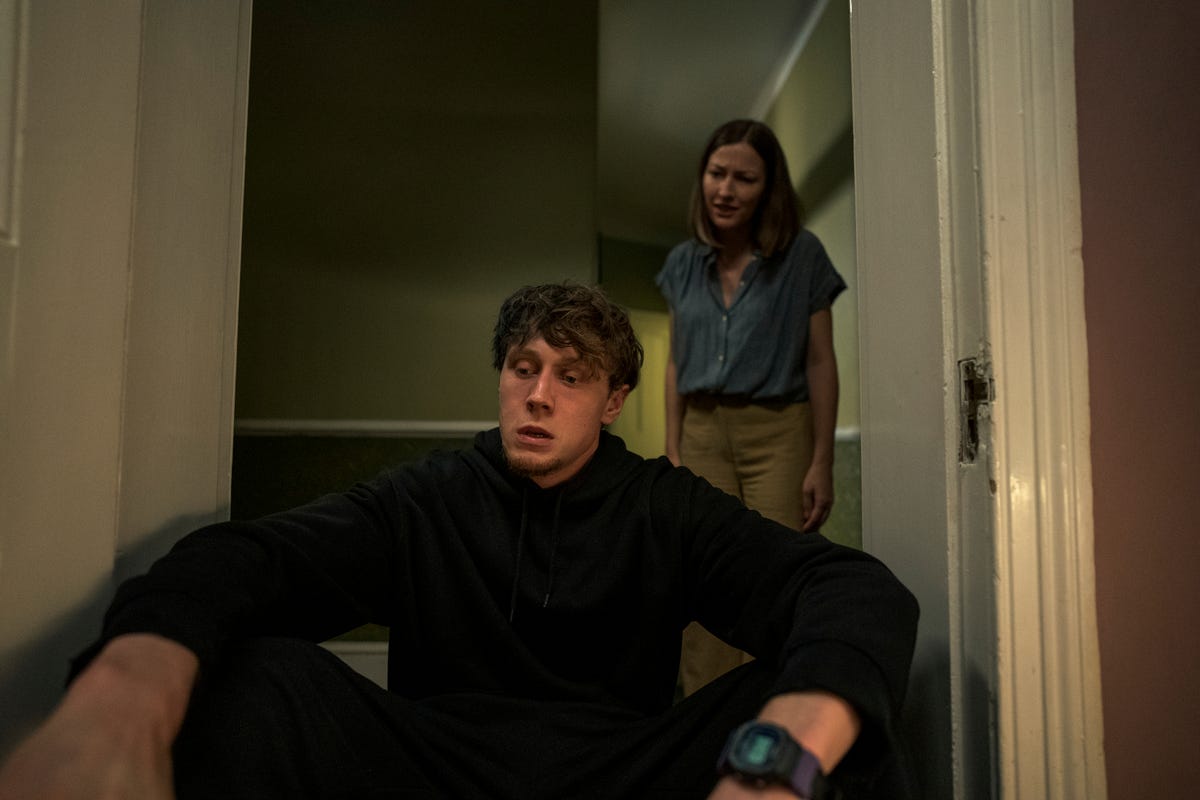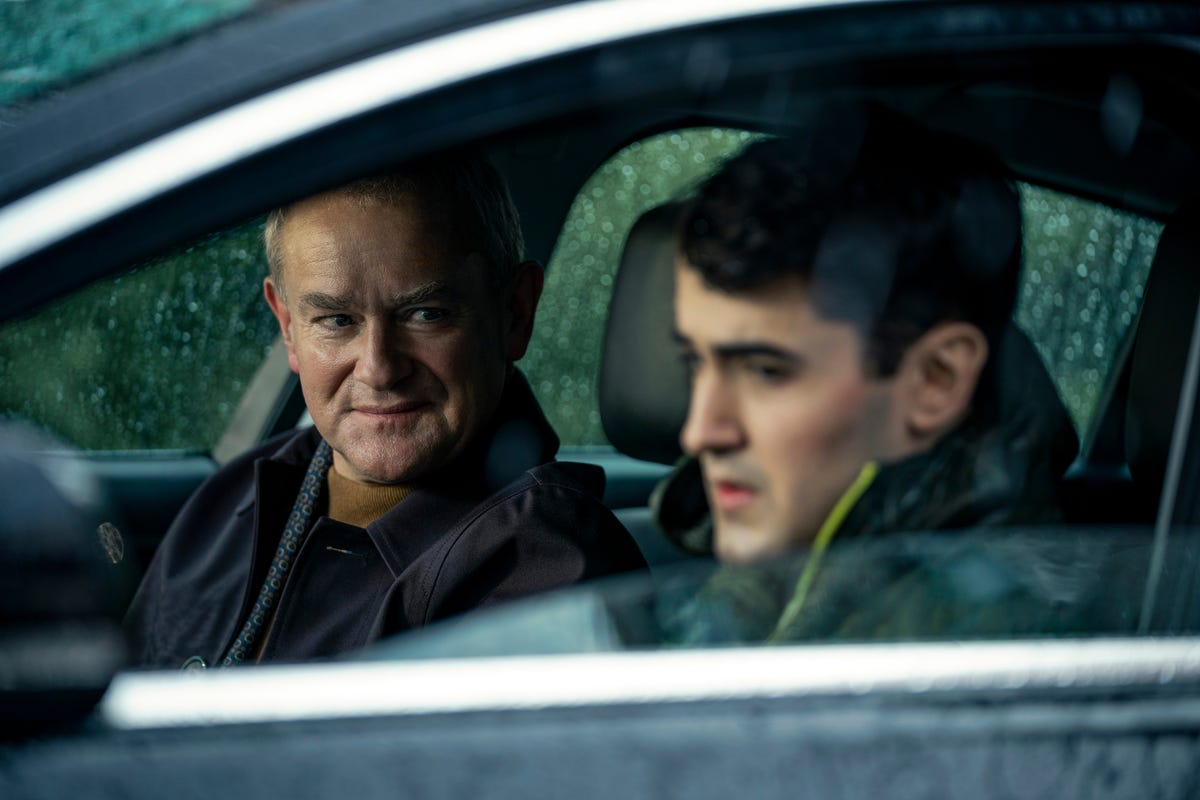
I Came By starts off as an on-the-nose social commentary about class and privilege but quickly turns into a disturbing horror flick. The Netflix movie stars some accomplished British actors and initially doles out several gripping twists.
But does it bring home a satisfying ending? Not really, given the confusion over the identity of a particular person in a particular basement. Plus, when it seemed certain characters would survive, they ended up incinerated off screen.
Let’s drill into this frustrating flick.
Read more: The Best Shows on Netflix
Spoilers ahead and a content warning: sexual violence, self-harm, suicide

These two do not have an easy time.
Nick Wall/Netflix
Who is Hector Blake?
That’s Sir Hector Blake. He was shipped away to board at Birlstone School as a junior. He later studied law and became a High Court judge, but recently retired after 30 years. He was regarded as a “saint,” known for his “philanthropic work on behalf of refugees.” He was involved in a prominent fictional case with Kazima Ajang in 2016, according to a letter he receives from a student asking him if he’ll read their dissertation. (He promptly chucks it in the bin.)
This is all a thin veil hiding Blake’s true identity. Toby reads up on Blake, discovering his family were all “staunch colonialists,” his father a factory owner. Blake quit being a High Court judge after a year, calling the bench too “white and elitist” seemingly to avert attention from his own shady history.
He also reveals his wife is in Chesham House, a psychiatric hospital. He regularly plays squash with police superintendent William Roy and, crucially, likes watching Rick and Morty.
What are Blake’s motivations?
Why is Blake drugging migrant workers and imprisoning at least one person in his basement? Much of his creepy conversation with Omid when he invites Omid over to his fancy house reveals his motivations.
Blake says his father invited Ravi to live in their house “like a member of the family.” Eventually, he invited Ravi “into his bed.” According to Blake, this drove his mother to suicide. Blake was the one who discovered her with her wrists sliced open. Shipped off to boarding school, Blake believed his father had replaced him and his mother with Ravi. He calls Ravi a “peasant” and says he “hated” him.
A line Toby’s friend Jay (Percelle Ascott) says at the beginning of the movie, referencing a portrait of Blake’s father, suggests Blake is acting in the same way as his father. “Is that your old man? I can see the resemblance.” Blake proceeds to stare at the portrait meaningfully.
Blake might also be gay, but the “rage” inside him is “very hard to suppress” when it comes to the boy he hated growing up — Ravi. It’s possible Blake wrestles with his hatred for anyone echoing Ravi, as well as his sexual feelings for them. This could be why he keeps Said alive and entrapped in his basement, similar to how his father kept Ravi as his prisoner, of sorts.
Is that Ravi in the basement?
The answer is no. The man kept chained in the basement of Blake (Hugh Bonneville, of Downton Abbey fame) definitely isn’t Ravi. How do we know that?
For one thing, the timing would be way off. Blake told his masseuse Omid (Yazdan Qafouri) that growing up, his family had a young Indian-Persian helper named Ravi. His father “came across him working in his factory, and decided to take him under his wing.” Blake says he was a “little boy” himself at the time and was later shipped off to boarding school at age 9. In a photo rebellious graffiti artist Toby (George MacKay) inspects in Blake’s house after breaking in, there are two boys: one who appears to be Blake and a much taller one who appears to be Ravi. This all indicates Ravi was likely older than Blake, so the young man found chained in his basement must be someone else, probably another migrant worker. Blake’s backstory reveals he despised Ravi, and it appears he’s still on a vendetta to unleash his bouts of rage on more victims.
The main reason we know the man isn’t Ravi is because IMDb lists the prisoner’s name as Said and says he’s played by Tarik Badwan.

Hector Blake blackmails Omid into getting in his car.
Nick Wall/Netflix
What happens to Ravi?
“I thought I’d killed him, one summer when I came back from school. I pounced on him like a savage beast,” Blake tells Omid. “Nearly destroyed his face.” Toby discovers a photograph of Ravi with the side of his head looking bloodied, apparently the aftermath of this attack.
We never hear the end of the story, so it’s understandable to connect the dots and think Ravi was the prisoner in Blake’s basement, not Said. Potentially, Blake treated Ravi the same way as his other victims: killing him and burning the remains.
What happens to Omid?
After Omid manages to escape Blake’s house despite being drugged, Blake essentially blackmails Omid into getting in his car, warning he has the power to either stop or expedite his application for permanent settlement in the UK. We later see Blake in his basement, holding Omid’s phone, which has a smear of blood on it.
Omid can be heard banging on the secret room’s door, yelling to be freed. (By now, Said would have been moved to Blake’s other secret room in his garage.) Blake’s clothes are off, suggesting either he and Omid had sex before Blake trapped him, or Blake is simply burning his clothes and any evidence of blood. Blake later chops Omid up and incinerates him in his kiln (which belonged to his pottery-loving wife), just as he did with Toby and then his mother Elisabeth.
What’s the final message of ‘I Came By’?
A literal “I came by” graffiti tag is left on the wall in Blake’s house after he’s captured. Sadly, it isn’t Toby who’s able to give his final triumphant stamp. He never gets to show his mother Elisabeth and the world that he really did care about big issues (although, maybe Elisabeth understood once she, too, saw Blake’s true self). Instead, it’s Jay who writes the message in Toby’s honor.
Director Babak Anvari said that, when it comes to themes, I Came By is “very timely.”
“The core of it is about how institutions can fail us, and if the institutions are failing us, shouldn’t we, as individuals, take responsibility and have each other’s backs?” Anvari said. “So that was like the central theme of it that I really wanted to tap into.”
